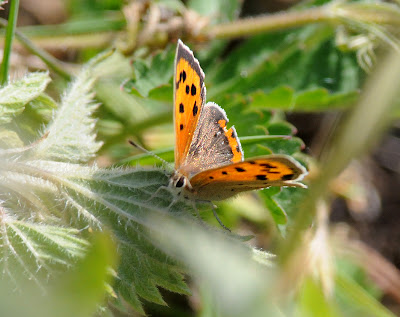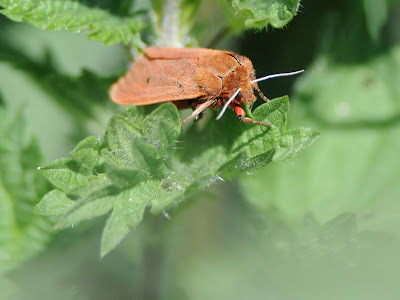Today I had the great pleasure of a guided tour around New Hythe gravel pits, courtesy of Phil Sharp (Sharp by Nature blogger, and thoroughly decent bloke). It was a lovely day with a much less ferocious north-easterly wind than of late, and we had a fantastic walk around the lakes and extensive marshy and scrubby areas in between. I'm afraid I lost track of which lake was which and where we were somewhat, so apologies for any locational vagueness.
We hurried along the first part of the walk to get away from the rather noisy and smelly paper mill, but I couldn't resist a quick pause to photograph this showy Reed Warbler, one of dozens heard today. This one was in a small reedbed on the edge of Brooklands Lake.
We followed the path along the Medway. Here, the river is tidal and this morning the tide was low, exposing lots of muddy and gravelly foreshore. On it were numerous Grey Herons and Black-headed Gulls plus a few Shelducks, but not the hoped-for waders. Oh, and this Fox.
This Reed Bunting was singing from one of the small hawthorns growing out of the sunken marsh area. Here we also heard Cetti's Warbler and the soft, unassuming 'tsip' of Bullfinches. I tried to turn a half-hidden male Chaffinch into a Bullfinch, to no avail, but then saw a nice indisputable male Bullfinch flit by, TFFP (too fast for photos). Then Phil picked up the soft purr of a Turtle Dove, his first of the year (and mine too). We tracked the purr to a nearby bank of dense bushes, but the dove was too shy to show itself.
This Cuckoo, calling constantly and sounding as though it had a sore throat on the 'oo' part of its two-tone song, didn't mind being observed - from a distance. This was the closest we got, before it flew off, though we did briefly see it or another one fly past at close range down the river.
Another sunken marsh denizen - a nice Chiffchaff. We also heard plenty of Blackcaps and Common Whitethroats here, and a bit further along a well-hidden Lesser Whitethroat.
Heading away from the river, Phil led me along a wide grassy path through drier and scrubbier habitat, where we paused to enjoy two competing Nightingales in full, glorious song. One of them even afforded us a brief glimpse of his russet backside as he flew from one hiding place to another. This lovely perched Hairy Hawker was compensation for lack of Nightingale photos.
We continued to an area known as the East Scrub. Here there are a few refugia, and we took a look under them. The first two were blanks, but number three revealed this gorgeous Slow-worm. Both Phil and the Slow-worm were very patient with me as I faffed about with my camera - Phil holding the plastic sheet aloft and the Slow-worm staying put even when the sunlight fell on it, but thanks to my big lens I had to settle for a headshot as the whole reptile wouldn't fit in the frame.
We stopped by a small, reedy ditch and watched Hairy Hawkers flying up and down it. Then a small butterfly flitted by and settled for a bask. I was delighted to see it was a Small Copper, my favourite butterfly and the first one I'd seen in 2011. I was slightly less delighted when it flitted off again after I'd only taken one rather rubbish photo of it.
Continuing along the stream, we paused to look for Water Voles, and as if on cue one dropped into the water on the far side and swam towards me. I missed the chance for a shot, but the patient vole swam back again and gave me another opportunity.
We were walking up and down looking for more voles when a falcon shot past at close range and disappeared behind a distant tree. Happily it reappeared. A Hobby - first of the year for both of us. We saw another three over the rest of the walk - never very close, but in this shot you can see (just) that it's bringing its talons up to its bill to munch some small flying thing it's just caught.
Another look at the Hobby, just because it's a Hobby.
Wandering on through the scrub, we finally found a dragon which wasn't a Hairy Hawker. It laned in a convenient spot on a hawthorn - first Four-spotted Chaser of 2011 and what a beauty it was.
Walking back over the scrub, we found up to five Grizzled Skippers racing about and pausing for the occasional rest. They all looked in lovely condition, and Phil suspects they are newly emerged, a few weeks behind their downland counterparts.
Another interesting butterfly in the same area - I thought at first it was a female Common Blue but then changed my mind on seeing the big orange lunules and lack of blue fluff against the body - a Brown Argus. The underwing pattern confirmed it - beautiful little butterfly, and this photo doesn't do it justice at all.
We were on the return stretch now, on a different path further back from the river. I paused to photograph one of the many dangly caterpillars we'd seen. I had immense difficulty getting a photo lock on it though, until Phil assisted by providing me with a larger nearby focus point (his finger, pointing at the caterpillar). The thread the caterpillar is hanging from is almost invisible, but there was one there, honest.
We had seen a few Holly Blues already, but stopped to watch this female as she laid her eggs. Not sure what the plant was but it was neither holly nor ivy. As we watched, Phil mentioned that he'd noticed butterflies drooping their antennae while egg-laying. We wondered whether the effort of egg-laying makes the butterfly too tired to hold its antennae in the standard upright position.
Passing a luxuriant stand of nettles and brambles, we noticed several interesting insects on the leaves. One was this colourful chap, which I said I thought was called the Red and Black Froghopper. I just looked it up and I was wrong, it's actually called the Black and Red Froghopper.
While I was admiring the froghopper, Phil spotted a colourful moth which helpfully landed not too far away. It was a Ruby Tiger, hiding its scarlet hindwings under the slightly duller red forewings at rest, but showing off a smart red armband.
There were lots of damselflies about in the more sheltered areas. Some were fully coloured and pairing up, but many were teneral and are going to be tricky to ID. Not so this one - a gorgeously delicate Blue-tailed.
For our last stop, we climbed up to the 'raptor viewpoint' which overlooks two lakes and gives fantastic views of the hills beyond. The sky was full of Black-headed Gulls, athletically hawking for flies. Among them flew a single beautiful adult Mediterranean Gull, and treated us to several close fly-pasts before powering away towards the river.
We'd been out for about five hours, but it felt like half that. This is a lovely area, with a much wider and wilder 'feel' than I'd anticipated after looking at it on maps. Thanks, Phil, for a great morning/afternoon, and I'm sure I'll be back before too long!
Subscribe to:
Post Comments (Atom)





















5 comments:
Great set of sightings and photos!
A very nice account Marianne and some great photos too. I really like the Reed Warbler shot, especially as it's doing exactly what it says on the tin, warbling in the reeds!
Pleased you also got a lovely Water Vole shot as well.
All in all a great day.
A delightful post and lovely photos Marianne!
I particularly liked the Reed Warbler and the Water Vole and I am very envious of the sighting of the Water Vole. I haven't seen one for years!
Hi Marianne,
Thanks for visiting my blog! I see you have met Phil, I agree he is a great bloke! Looks like you had a cracking day there with him.
Hi Marianne.
I am glad you had a lovely day out with Phil,it's a nice place for wildlife, and your right about Phil,he is a nice guy(he paid me to say that).
Great photo's, and blog.
Post a Comment